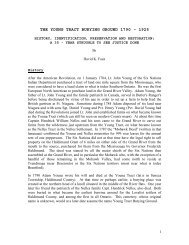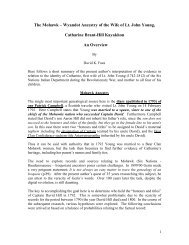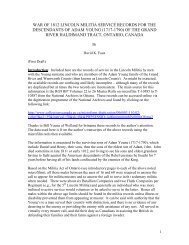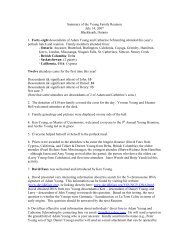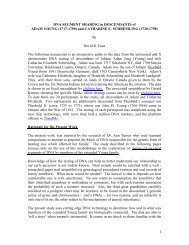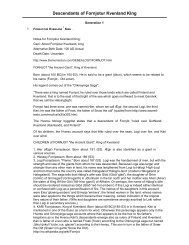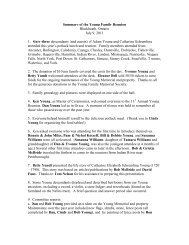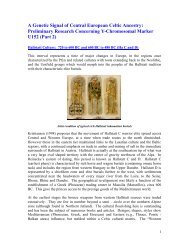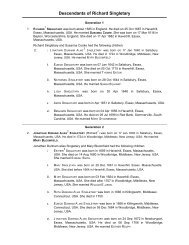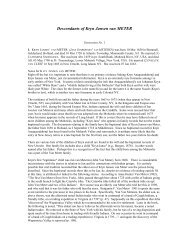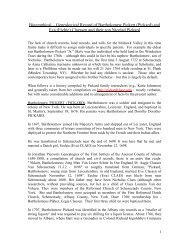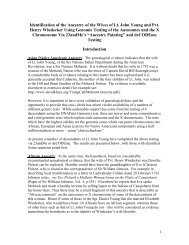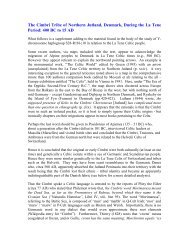Y-Chromosome Marker S28 / U152 Haplogroup R ... - Davidkfaux.org
Y-Chromosome Marker S28 / U152 Haplogroup R ... - Davidkfaux.org
Y-Chromosome Marker S28 / U152 Haplogroup R ... - Davidkfaux.org
You also want an ePaper? Increase the reach of your titles
YUMPU automatically turns print PDFs into web optimized ePapers that Google loves.
chromosome. The event presumably happened only once in the history of mankind.<br />
Thus some thousands of years ago a spot mutation occurred during meiosis in an R-<br />
P312* father. The mutation was passed to his son who in turn passed it on to every one of<br />
his descendants in the direct male line. Thus all R-<strong>U152</strong> males have the same ancestor in<br />
the Y-line, although the age of the mutation (when <strong>S28</strong> / <strong>U152</strong> first appeared) has not<br />
been determined.<br />
How old is the mutation? There is no molecular clock which will provide an absolute<br />
dating such as dendochronology (tree ring dating). The date depends on a host of<br />
assumptions such as generation age, whether to consider back mutations, accepting a<br />
mutation rate and so on. Robert McGregor used the Zhivotovsky et al. (2006) approach<br />
and obtained a date for the Most Recent Common Ancestor of 11,400 years (plus or<br />
minus 1000 years) of all those in the author’s database. Vince Vizachero has estimated<br />
the age of <strong>S28</strong> as 6600 years (Neolithic), and Dr. Ken Nordtvedt has obtained a date of<br />
about 3700 years (Bronze Age). While due consideration must be given these estimates,<br />
it is highly likely that what is being detected is an expansion of this haplogroup, whereas<br />
its origin lies in the Mesolithic, about 10,000 years ago. Thus the present author is<br />
inclined to accept the McGregor estimate since it accords best with all other data sources.<br />
Ultimately only ancient DNA samples are going to settle the matter to everyone’s<br />
satisfaction.<br />
What are some of the technical aspects of the <strong>S28</strong> / <strong>U152</strong> SNP? The essential facts can<br />
best be expressed in chart form:<br />
<strong>Marker</strong> Rs # Forward PCR primer Reverse PCR primer Product Size SNP position (bp)<br />
(5’-3’)<br />
(5’-3’)<br />
(bp)<br />
<strong>U152</strong> rs1236440: G>A cttagctatacagcctctttttgg aacattccacgcttgaggataa 172 127<br />
What does the G to A mutation of a male who is <strong>S28</strong> / <strong>U152</strong>+ look like along the<br />
sequence of base pairs in the vicinity of the marker? This can best be viewed by a<br />
pherogram / chromatogram printout from the program Sequencher to see the difference<br />
between an ancestral and derived Y-chromosome at this location.<br />
Where on the Y-chromosome is the <strong>S28</strong> / <strong>U152</strong> mutation? This marker can be viewed<br />
via the Y-chromosome browser created by Thomas Krahn.<br />
Is there any way to relate <strong>S28</strong> / <strong>U152</strong> to the broad east – west classification system for<br />
R-M269? There appears to be an important division between the most common forms of<br />
R-M269 from Bulgaria eastward versus westward. An “old – fashioned” marker that is<br />
seldom used in studies today is the p49a,f Taq haplotype system. Cinnioglu et al. (2004)<br />
used this in describing their samples from locations such as Turkey and Armenia and<br />
those from Iberia and other locations in western Europe. The division is dramatic,<br />
Haplotype 35 is characterisitic of most R-M269 east of the Balkans, whereas Haplotype<br />
15 is most common in western Europe. Unfortunately no company at present will do<br />
commercial testing for this marker, but Vincent Vizachero has found a set of markers that<br />
can act as surrogates. The evidence is very clear, if someone has DYS393=12,<br />
DYS461=11, and DYF385=9,10 or 10,10 then it would appear that they are of the<br />
2



